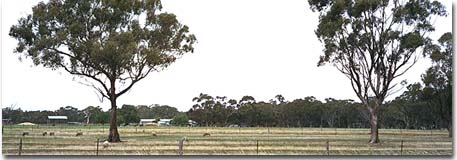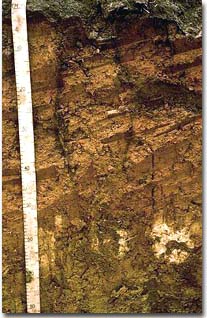IS30
Location: Haven
Soil Type: Haven Sandy Loam (shallow phase)
Australian Soil Classification: Calcic, Mesonatric, Brown SODOSOL
Northcote Factual Key: Dy 2.33
Great Soil Group: solodised solonetz
Mapping Unit: Haven sandy clay loam dominant, Haven sandy loam sub-dominant complex.
General Landscape Description: Level area in an extensive interdune swale situation.
Site Description: Originally under pasture. This site is six kilometres south of Horsham adjacent to the Henty Highway.
Geology: Late Tertiary to Quaternary. Quaternary Shepparton Formation: fluvial silt, sand and minor gravel.
Native Vegetation: Originally a tall woodland formation of Grey Box (Eucalyptus microcarpa), Buloke (C. luehmannii) and Yellow Gum (E. leucoxylon).
 IS30 Landscape |
Soil Profile Morphology:
Surface Soil
| A1 | 0-5 cm | Dark brown (10YR3/3); sandy loam; hardsetting surface condition; weak blocky structure; strong consistence dry, slightly sticky consistence wet; pH 6.4; sharp and wavy change to: |  IS30 Profile |
| Subsoil | |||
| B1 | 5-20 cm | Strong brown (7.5YR5/6) sporadically bleached (10YR7/4); medium clay; moderate coarse columnar structure; strong consistence dry, slightly sticky consistence wet; pH 8.4; gradual change to: | |
| B21 | 20-35 cm | Strong brown (7.5YR5/6); sandy clay; coarse columnar structure; strong consistence dry, slightly sticky consistence wet; pH 8.0: | |
| B22 | 35-55 cm | Strong brown (7.5YR5/6); sandy clay; subplastic; coarse columnar structure; strong consistence dry, slightly sticky consistence wet; pH 8.9; gradual change to: | |
| B31k | 55-85 cm | Brownish yellow (10YR6/6); sandy clay; weak blocky structure; strong consistence dry, slightly sticky consistence wet; contains a few (2-10 %) soft carbonates; pH 9.3; gradual change to: | |
| B32 | 85-130 cm | Brownish yellow (10YR6/6) with pale yellow (5Y7/3) mottles; light clay; weak blocky structure; strong consistence dry, slightly sticky consistence wet; contains very few (< 2 %) soft carbonates; pH 9.2. |
Key Profile Features:
- Strong texture contrast between surface (A) horizon (13% clay) and subsoil (B21) horizon (58 % clay).
- Columnar structure in upper subsoil.
Soil Profile Characteristics:
pH | Salinity Rating | |||
Surface (A1 horizon) | Slightly Acid | Medium | Non-Sodic | None 1 |
Subsoil (B21 horizon) | Moderately Alkaline | Medium | Strongly Sodic | Complete |
Deeper Subsoil (at 1 m) | Very Strongly Alkaline | Very High | Very Strongly Sodic | None 2 |

| The surface soil is slightly acid. The subsoil is moderately alkaline becoming very strongly alkaline with depth. | The salinity rating is medium in the surface and upper subsoil becoming very high with depth. | The surface is non-sodic. The subsoil is strongly sodic. | The clay content increases markedly at the surface / subsoil boundary then becomes more sandy at 20 cm depth. |
Chemical and Physical Analysis:
Horizon | Sample Depth cm | pH H2O | EC dS/m | Sodium Chloride % | Exchangeable Calcium cmol-/kg | Exchangeable Magnesium cmol-/kg | Exchangeable Potassium cmol-/kg | Exchangeable Sodium cmol-/kg | Organic Carbon % | Total Nitrogen % | Exchangeable Acidity cmol-/kg | Field Capacity -30okPa | Permanent Wilting Point -1500okPa | Coarse Sand % | Fine Sand % | Silt % | Clay % |
A1 | 0–5 | 6.4 | 0.18 | 0.03 | 1.9 | 2.6 | 0.3 | 0.4 | 1.53 | 0.12 | 7.9 | 12.6 | 5.7 | 39 | 44 | 3 | 13 |
B21 | 5–20 | 8.4 | 0.15 | 0.01 | 2.4 | 6.9 | 2.3 | 0.5 | 0.91 | 0.09 | 4.5 | 20.1 | 9 | 18 | 10 | 58 | |
B22 | 20–35 | 8 | 0.34 | 0.07 | 2.9 | 9.8 | 1 | 3.6 | 0.31 | 0.04 | 4 | 14.6 | 30 | 35 | 1 | 34 | |
B23 | 35–55 | 8.9 | 0.69 | 0.12 | 2.6 | 11.9 | 1 | 5.1 | 0.22 | 0.02 | 2.7 | 15.7 | 32 | 28 | 2 | 38 | |
B31k | 55–85 | 9.3 | 0.97 | 0.16 | 2.9 | 11.4 | 0.7 | 5.2 | 0.14 | 0.01 | 14.8 | 26 | 34 | 1 | 35 | ||
B32 | 85–130 | 9.2 | 1.18 | 0.21 | 2.7 | 15.6 | 0.8 | 7.4 | 0.12 | 0.01 | 17.1 | 25 | 27 | 3 | 42 |
Management Considerations:
Whole Profile
- Plant available water capacity (PAWC) is considered to be very low (estimated at 10 mm) for this site. This is based on available laboratory data and assumes an effective rooting depth of 5 cm. Effective rooting depth is likely to be significantly restricted by the dense, strongly sodic and dispersive subsoil.
- The surface soil is shallow which provides a shallow rooting environment for many plants as the subsoil is restrictive to root growth. Building up of organic matter levels should be encouraged in order to increase soil fertility, aggregation and water holding capacity.
- The shallow surface soil is likely to become waterlogged after heavy rains due to very low subsoil permeability.
- The dense and coarsely structured upper subsoil is sodic (as well as having a low calcium to magnesium ratio) and therefore disperses strongly to completely in water. This indicates that water and root movement will be significantly restricted in the subsoil. The dispersive subsoil is likely to be highly erodible to water when exposed, so it is important to maintain a protective cover of surface soil and plant cover.
- The level of soluble salts becomes medium to high in the deeper subsoil (from 35 cm depth). At these levels, the growth of salt sensitive species (eg. faba beans, linseed, chick peas and lupins) may be restricted.
- The subsoil is strongly to very strongly alkaline from 35 cm depth. This indicates that some nutrients (eg. manganese, zinc, copper and iron) may be poorly available to plants.
Reference: "Major Agricultural Soils of the Wimmera Irrigation Area". John Martin, Mark Imhof, Lourey Ruth, Rob Nink, Karen DePlater, Paul Rampant, Sonia Thompson, S. Alexander. Department of Natural Resources and Environment, Victoria. 1996.


